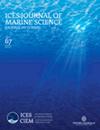高分辨率船只跟踪数据标准化分析工作流程
IF 3.4
2区 农林科学
Q1 FISHERIES
引用次数: 0
摘要
了解在海洋环境中开展活动的时空分布情况,是对现有空间进行优化管理的关键。然而,关于海洋空间最大用户(即渔民)的分布情况,往往只有很少或根本没有信息。人们越来越多地使用跟踪设备来获取捕鱼活动的高分辨率地理空间数据,时间间隔从几秒到几分钟不等。然而,到目前为止,还没有标准化的方法来处理和分析这些数据,因此很难进行重复分析。我们开发了一套工作流程,用于识别单个渔船行程,并从高分辨率地理空间数据中推断捕鱼活动,该流程可用于大型渔业,但也考虑到了小型渔业工作中遇到的细微差别。由于认识到不同船队所开展活动的高度可变性,该工作流程允许用户选择最符合所分析渔业特殊性的路径。此外,还介绍了一种确定小型渔业锚泊地点的新方法。本文用 R 语言和 Python 语言提供了工作流程每个步骤中使用的详细代码,以扩大工作流程在科学界和利益相关者群体中的应用,并鼓励今后对其进行改进和完善。本文章由计算机程序翻译,如有差异,请以英文原文为准。
A workflow for standardizing the analysis of highly resolved vessel tracking data
Knowledge on the spatial and temporal distribution of the activities carried out in the marine environment is key to manage available space optimally. However, frequently, little or no information is available on the distribution of the largest users of the marine space, namely fishers. Tracking devices are being increasingly used to obtain highly resolved geospatial data of fishing activities, at intervals from seconds to minutes. However, to date no standardized method is used to process and analyse these data, making it difficult to replicate analysis. We develop a workflow to identify individual vessel trips and infer fishing activities from highly resolved geospatial data, which can be applied for large-scale fisheries, but also considers nuances encountered when working with small-scale fisheries. Recognizing the highly variable nature of activities conducted by different fleets, this workflow allows the user to choose a path that best aligns with the particularities in the fishery being analysed. A new method to identify anchoring sites for small-scale fisheries is also presented. The paper provides detailed code used in each step of the workflow both in R and Python language to widen the application of the workflow in the scientific and stakeholder communities and to encourage its improvement and refinement in the future.
求助全文
通过发布文献求助,成功后即可免费获取论文全文。
去求助
来源期刊

ICES Journal of Marine Science
农林科学-海洋学
CiteScore
6.60
自引率
12.10%
发文量
207
审稿时长
6-16 weeks
期刊介绍:
The ICES Journal of Marine Science publishes original articles, opinion essays (“Food for Thought”), visions for the future (“Quo Vadimus”), and critical reviews that contribute to our scientific understanding of marine systems and the impact of human activities on them. The Journal also serves as a foundation for scientific advice across the broad spectrum of management and conservation issues related to the marine environment. Oceanography (e.g. productivity-determining processes), marine habitats, living resources, and related topics constitute the key elements of papers considered for publication. This includes economic, social, and public administration studies to the extent that they are directly related to management of the seas and are of general interest to marine scientists. Integrated studies that bridge gaps between traditional disciplines are particularly welcome.
 求助内容:
求助内容: 应助结果提醒方式:
应助结果提醒方式:


